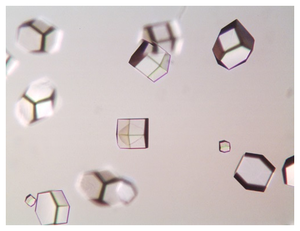Lysozyme - Solution
Crystallization grade model protein
Mucopeptide N-acetylmuramoyl-hydrolase, Muramidase
| Catálogo Nº | Apresentação | Preço (R$) | Comprar / Observação |
|---|---|---|---|
| CO-401 | 5 ml | Sob demanda | Adicionar ao Carrinho |

Lysozyme crystals grown in the presence of 8 % w/v Sodium Chloride and 100 mM Sodium Acetate pH 4.2.
For general laboratory use.
Envio: shipped at ambient temperature
Condições de armazenamento: store at 4 °C
do not freeze
Validade: 12 months
Peso molecular: 14.3 kDa (single chain)
CAS#: 12650-88-3
Número CE: 235-747-3
Forma: aqueous solution
Concentração: 20 mg/ml
pH: 3.5 (H2O, 20 °C)
Solubilidade: 300 g/l in water
Atividade: 50 kU/mg (Micrococcus luteus, FIP-Standard; pH 7.0; 25 °C)
Formulários:
Lysozyme can be utilized as model protein in crystallization experiments and X-ray structure analysis.
Descrição:
Lysozyme is a glycosidase which hydrolyzes the ß 1,4 glycosidic bond between N-acetylmuramic acid and N-acetyl-D-glucosamine residues in the bacterial peptidoglycan[1].
Source: Chicken egg white
Usage:
Crystals can be grown using the sitting drop, hanging drop or microbatch method.
Following crystallization conditions are suggested for lysozyme crystal growth:0.7 - 1.5 M Sodium Chloride, 100 mM Sodium Acetate pH 4.0 - 4.8[2]10 % w/v Sodium Chloride, 5% v/v Propanol[2]0.44 M Sodium Nitrate, 100 mM Sodium Acetate pH 4.6[2]
Referências selecionadas:
[1] Rye et al. (2000) Glycosidase mechanisms. Curr. Opin. Chem. Biol. 4:573.
[2] Gilliland et al. (2002) The Biological Macromolecule Crystallization Database: crystallization procedures and strategies. Acta Cryst. D 58:916.
